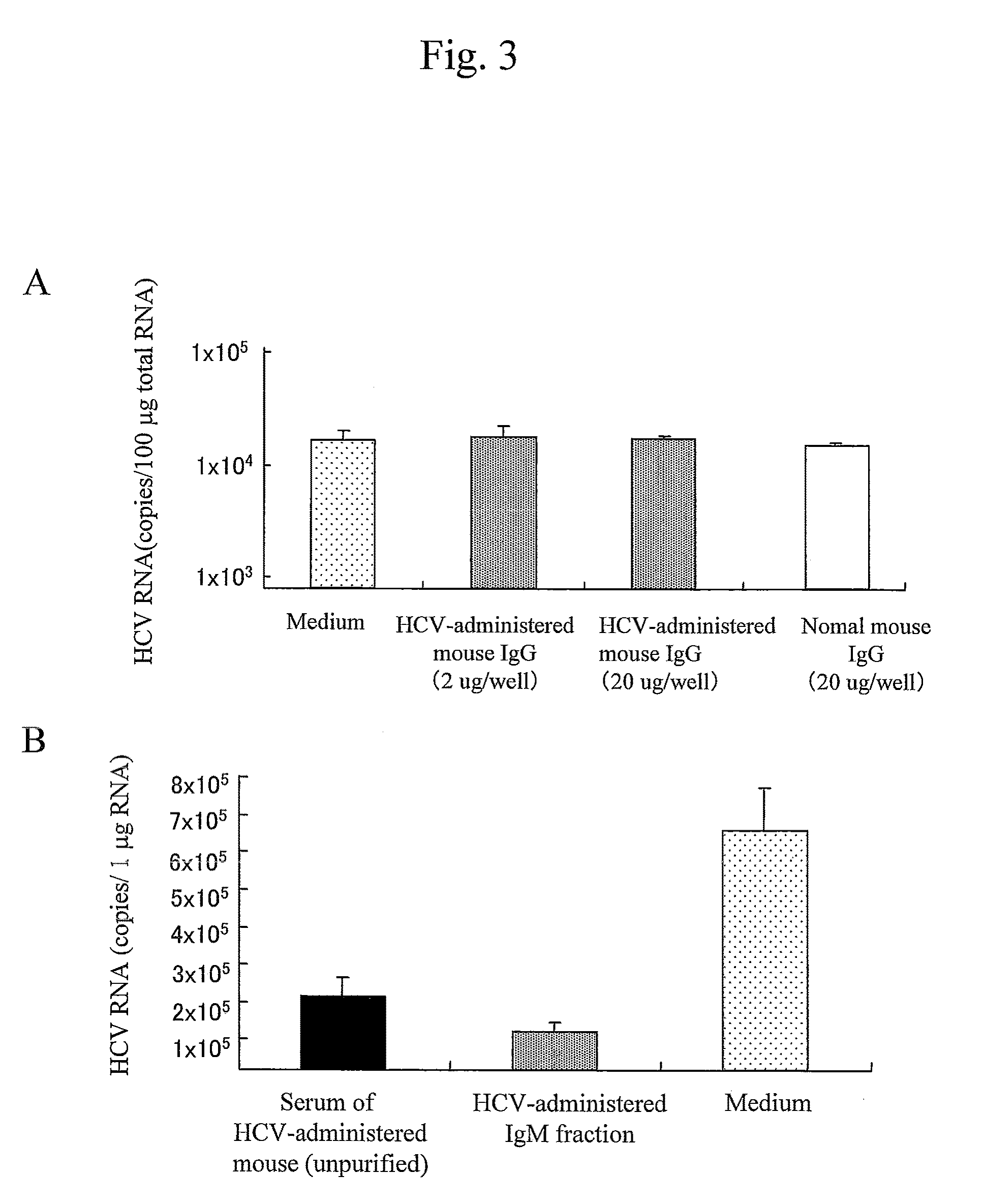Antibody having inhibitory activity on infection with hepatitis c virus (HCV) and use thereof
a technology of hepatitis c virus and antibody, which is applied in the field of antibodies having inhibitory activity on infection with hepatitis c virus (hcv), can solve the problems of increasing the number of patients, reducing the number of new hcv patients because of blood transfusion, and hepatitis c is a serious infection with poor prognosis
- Summary
- Abstract
- Description
- Claims
- Application Information
AI Technical Summary
Benefits of technology
Problems solved by technology
Method used
Image
Examples
example 1
Preparation of JFH-1-HCV Particles, J6 / JFH-1-HCV Particles, and TH / JFH-1-HCV Particles
[0116]pJFH-1, which is plasmid DNA obtained by cloning cDNA (genome-length cDNA) obtained via reverse transcription of the entire genome RNA region of the JFH-1 strain (genotype 2a) of the hepatitis C virus (HCV) isolated from a fulminant hepatitis patient downstream of the T7 RNA promoter sequence of the pUC19 plasmid, was prepared as described in Wakita, T. et al., Nat. Med., 11, 2005, pp. 791-796 and International Publication WO 2004 / 104198. The nucleotide sequence of the genome-length cDNA derived from the JFH-1 strain inserted into pJFH-1 is as shown in SEQ ID NO: 1. pJFH-1 was digested with EcoRI and then partially digested with Bell to prepare a plasmid DNA fragment, which lacks a fragment of approximately 2,840 bp from the EcoRI site to the first Bell site, and the resulting fragment was purified.
[0117]pJ6CF, which is obtained by cloning genome-length cDNA derived from the HCV J6CF strain (...
example 2
Purification of JFH-1, J6 / JFH-1, and TH / JFH-1 HCV Particles
[0127]The virus particles produced in Example 1 were purified via the following 4 steps.
1) Concentration
[0128]With the use of Pellicon 2 Mini Ultrafiltration Module PLCMK V 0.1 m2 (300 kDa cut-off, Catalog No. P2C300V01, Millipore, hereafter referred to as “pellicon 2 mini”), the culture supernatant containing the HCV particles obtained in the Example above was concentrated to approximately 30- to 50-fold. The concentrate was filtered through a 0.45-μm filter and then stored at −80° C.
2) Density-Gradient Ultracentrifugation
[0129]To the Ultra-clear 25×89 mm centrifuge tube (Catalog No. 344058, Beckman Coulter), 3 ml of TNE buffer containing cold 60% sucrose (10 mM Tris-HCl (pH 7.4), 150 mM NaCl, 1 mM EDTA) was added, and 7 ml of TNE buffer containing 20% sucrose was overlaid thereon. Further, 25 ml of the sample was overlaid onto the TNE buffer containing 20% sucrose. Ultracentrifugation was carried out using a SW-28 (Beckman...
example 3
Virus Inactivation
[0133]The concentrated hepatitis C viruses obtained by the steps 1) to 4) in Example 2 were inactivated via ultraviolet irradiation. As a source of ultraviolet rays, GL-15 (Toshiba) was used. The solution containing purified hepatitis C virus particles (the JFH-1 strain) having an infectious titer of 1×106 ffu / ml was introduced into a silicon-coated polyethylene Eppendorf tube (Assist Co., Ltd,), the tube was placed at a distance from the source of ultraviolet rays, so that the ultraviolet rays would be applied at the intensity of 20 mW / cm2, and UV-C was applied for 5 minutes.
[0134]After ultraviolet irradiation, hepatitis C virus particles were serially diluted 50-fold, 250-fold, 1,250-fold, 6,250-fold, 31,250-fold, 156,250-fold, and 781,250-fold in Dulbecco's modified Eagle medium (DMEM).
[0135]On the previous day, the Huh-7 cells were seeded on a 96-well poly-L-lysine-coated plate (Corning 96 Well Clear Flat Bottom Poly-L-Lysine Coated Microplate, Corning) at 1×10...
PUM
| Property | Measurement | Unit |
|---|---|---|
| body weight | aaaaa | aaaaa |
| pH | aaaaa | aaaaa |
| pH | aaaaa | aaaaa |
Abstract
Description
Claims
Application Information
 Login to View More
Login to View More - R&D
- Intellectual Property
- Life Sciences
- Materials
- Tech Scout
- Unparalleled Data Quality
- Higher Quality Content
- 60% Fewer Hallucinations
Browse by: Latest US Patents, China's latest patents, Technical Efficacy Thesaurus, Application Domain, Technology Topic, Popular Technical Reports.
© 2025 PatSnap. All rights reserved.Legal|Privacy policy|Modern Slavery Act Transparency Statement|Sitemap|About US| Contact US: help@patsnap.com



